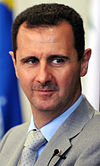
Ensuring national security, increasing influence among its Arab neighbours and securing the return of the Golan Heights, have been the primary goals of the Syrian Arab Republic's foreign policy. At many points in its history, Syria has seen tension with its neighbours, such as Turkey, Israel, Jordan, Iraq, and Lebanon. Syria enjoyed an improvement in relations with several of the states in its region in the 21st century, prior to the Arab Spring and the Syrian Civil War.
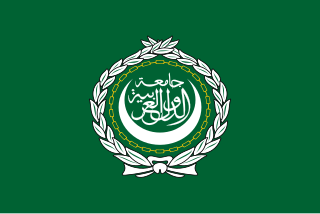
The Arab League, formally the League of Arab States, is a regional organization in the Arab world, which is located in North Africa, West Asia, and part of East Africa. The Arab League was formed in Cairo on 22 March 1945, initially with six members: Egypt, Iraq, Transjordan, Lebanon, Saudi Arabia, and Syria. Yemen joined as a member on 5 May 1945. Currently, the League has 22 members.

The Arab world, formally the Arab homeland, also known as the Arab nation, the Arabsphere, or the Arab states, comprises a vast group of countries, mainly located in Western Asia and Northern Africa. While the majority of people in the Arab world are ethnically Arab, there are also significant populations of other ethnic groups such as Berbers, Kurds, Somalis and Nubians, among other groups. Arabic is used as the lingua franca throughout the Arab world.
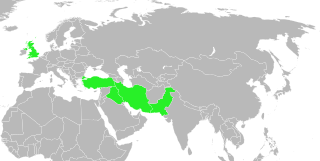
The Central Treaty Organization (CENTO), formerly known as the Middle East Treaty Organization (METO) and also known as the Baghdad Pact, was a military alliance of the Cold War. It was formed on 24th February, 1955 by Iran, Iraq, Pakistan, Turkey, and the United Kingdom. The alliance was dissolved on 16 March 1979.

The Middle East and North Africa is a geographic region whose countries are often referred to by the acronym MENA. It is also known as WANA, SWANA, or NAWA, which alternatively refers to the Middle East as West Asia or as Southwest Asia; this is another way to reference the geographical region, instead of using the more common political terminology.

Arab League–Iran relations refer to the political, economic, and cultural ties between the League of Arab States and the Islamic Republic of Iran. The former is a regional organization composed of 22 Arab states in MENA with a combined majority of Sunni Muslims, whereas the latter is a country in Western Asia with a majority of Shia Muslims.

Normal diplomatic relations were established between the Republic of Turkey (Türkiye) and the United States of America in 1927. Relations after World War II evolved from the Second Cairo Conference in December 1943 and Turkey's entrance into World War II on the side of the Allies in February 1945. Later that year, Turkey became a charter member of the United Nations. Difficulties faced by Greece after the war in quelling a communist rebellion, along with demands by the Soviet Union for military bases in the Turkish Straits, prompted the United States to declare the Truman Doctrine in 1947. The doctrine declared American intentions to guarantee the security of Turkey and Greece, and resulted in significant U.S. military and economic support. This support manifested in the establishment of a clandestine stay-behind army, denoted the "Counter-Guerrilla", under Operation Gladio. After participating with United Nations forces in the Korean War, Turkey joined the North Atlantic Treaty Organization in 1952.
Armenians in the Middle East are mostly concentrated in Iran, Lebanon, Cyprus, Syria, Jordan, Saudi Arabia and Jerusalem, although well-established communities exist in Iraq, Egypt, Turkey and other countries of the area including, of course, Armenia itself. They tend to speak the western dialect of the Armenian language and the majority are adherents of the Armenian Apostolic Church, with smaller Catholic and Protestant minorities. There is a sizable Armenian population in the thousands in Israel. There is also the Armenian Quarter in Jerusalem with a history that goes back 2,000 years.
Arabs in Turkey refers to the 1.5-5 million citizens and residents of Turkey who are ethnically of Arab descent. They are the third-largest minority in the country after the Kurds and the Circassians and are concentrated in a few provinces in Southeastern Anatolia. In addition to this native group, millions of Arab Syrian refugees have sought refuge in Turkey since the beginning of the Syrian civil war in 2011.

Jordan–Syria relations are bilateral relations between the sovereign states of Jordan and Syria. Relations between neighbours have ancient roots as both countries are historically parts of the Levant or Greater Syria. The two states were created after the First World War from former Ottoman dominions by way of a secret bilateral agreement between Britain and France.

Iran–Turkey relations are the bilateral relations between the Islamic Republic of Iran and the Republic of Turkey. The two states' relationship is complex and characterized by periods of both tension and cooperation, as both Iran and Turkey are fighting for influence in the Middle East through supporting opposing proxies as part of a proxy conflict. The two countries are also major trade partners and are perceived as mutually interdependent due to geographical proximity as well as historically shared cultural, linguistic, and ethnic traits.

United States foreign policy in the Middle East has its roots in the 19th-century Barbary Wars that occurred shortly after the 1776 establishment of the United States as an independent sovereign state, but became much more expansive in the aftermath of World War II. With the goal of preventing the Soviet Union from gaining influence in the region during the Cold War, American foreign policy saw the deliverance of extensive support in various forms to anti-communist and anti-Soviet regimes; among the top priorities for the U.S. with regards to this goal was its support for the State of Israel against its Soviet-backed neighbouring Arab countries during the peak of the Arab–Israeli conflict. The U.S. also came to replace the United Kingdom as the main security patron for Saudi Arabia as well as the other Arab states of the Persian Gulf in the 1960s and 1970s in order to ensure, among other goals, a stable flow of oil from the Persian Gulf. As of 2023, the U.S. has diplomatic relations with every country in the Middle East except for Iran, with whom relations were severed after the 1979 Islamic Revolution, and Syria, with whom relations were suspended in 2012 following the outbreak of the Syrian Civil War.

The Arab League or League of Arab States was founded by Egypt in 1945, has 22 members and seven observer members so far: Armenia, Brazil, Chad, Eritrea, Greece, Republic of India, Venezuela.

Iraqi–Turkish relations are foreign relations between Iraq and Turkey. From late 2011 relations between the two countries have undergone strained turbulence. The two countries share historical and cultural heritages.

Iraq–Syria relations are the bilateral/diplomatic relations between the sovereign states of Iraq and Syria. Both nations are neighbours and they share the Iraq–Syria border. Relations are marked by long-shared cultural and political links, as well as former regional rivalry. The two countries took their present form after the Sykes–Picot Agreement to dismember the Ottoman Empire into British and French spheres of influence after World War I.
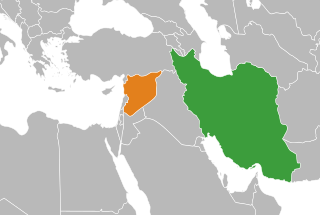
Syria and Iran are strategic allies. Syria is usually called Iran's "closest ally", with ideological conflict between the Arab nationalism ideology of Syria's secular ruling Ba'ath Party and the Islamic Republic of Iran's pan-Islamist policy notwithstanding. Iran and Syria have had a strategic alliance ever since the Iran–Iraq War, when Syria sided with non-Arab Iran against neighbouring Ba'ath-ruled Iraq. The two countries shared a common animosity towards then Iraqi president Saddam Hussein and coordination against the United States and Israel.
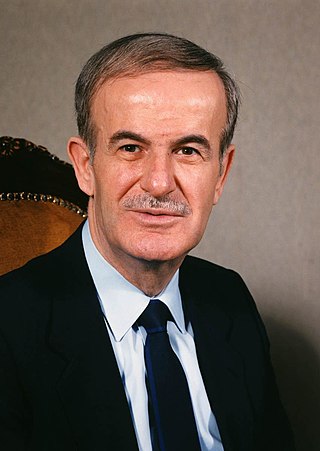
Hafez al-Assad served as the President of Syria from 12 March 1971 until his death on 10 June 2000. He had been Prime Minister of Syria, leading a government for two years. He was succeeded by his son, Bashar al-Assad.

The Arab League boycott of Israel is a strategy adopted by the Arab League and its member states to boycott economic and other relations between Arabs and the Arab states and Israel and specifically stopping all trade with Israel which adds to that country's economic and military strength. A secondary boycott was later imposed, to boycott non-Israeli companies that do business with Israel, and later a tertiary boycott involved the blacklisting of firms that do business with other companies that do business with Israel.

Iran and Saudi Arabia are engaged in an ongoing struggle for influence in the Middle East and other regions of the Muslim world. The two countries have provided varying degrees of support to opposing sides in nearby conflicts, including the civil wars in Syria and Yemen; and disputes in Bahrain, Lebanon, Qatar, and Iraq. It also extends to disputes or broader competition in other countries globally including in West, North and East Africa, South, Central, Southeast Asia, the Balkans, and the Caucasus.
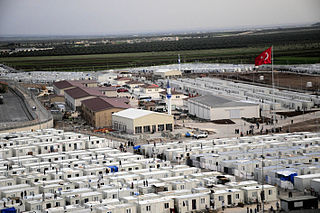
Turkey's migrant crisis, sometimes referred to as Turkey's refugee crisis, was a period during the 2010s characterised by a high number of people migrating to Turkey. Turkey received the highest number of registered refugees of any country or territory each year from 2014 to 2019, and had the world's largest refugee population according to the United Nations High Commissioner for Refugees (UNHCR). The majority were refugees of the Syrian Civil War, numbering 3.6 million as of June 2020. In 2018, the UNHCR reported that Turkey hosted 63.4% of all "registered Syrian refugees."

